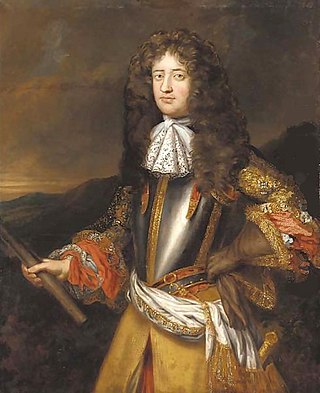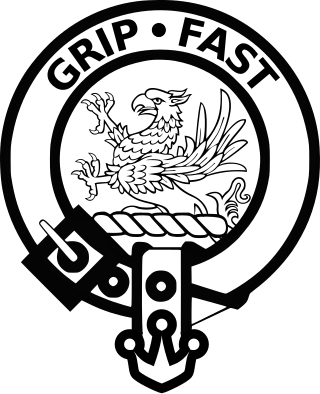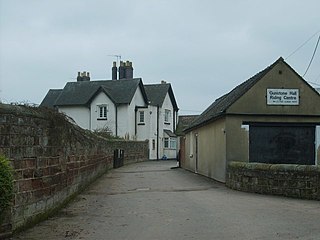Related Research Articles

English Tangier was the period in Moroccan history in which the city of Tangier was occupied by England as part of its colonial empire from 1661 to 1684. Tangier had been under Portuguese control before Charles II of England acquired the city as part of the dowry when he married the Portuguese infanta Catherine. The marriage treaty was an extensive renewal of the Anglo-Portuguese Alliance. It was opposed by Spain, then at war with Portugal, but clandestinely supported by France.
Andrew Rutherford, 1st Earl of Teviot was a Scottish soldier.

Major-General George Douglas, 1st Earl of Dumbarton KT was a Scottish military officer who spent much of his career in the service of King Louis XIV. In 1678, he returned to England; as a Catholic, he was a trusted servant of King James II and went into exile with him after the 1688 Glorious Revolution. He died at the palace of St Germain-en-Laye in March, 1692.

The Scots Guards (SG) is one of the five Foot Guards regiments of the British Army. Its origins are as the personal bodyguard of King Charles I of England and Scotland. Its lineage can be traced back to 1642 in the Kingdom of Scotland, although it was only placed on the English Establishment in 1686.

Clan Leslie is a Lowland Scottish clan. The progenitor of the Clan, Bartolf, was a nobleman from Hungary, who came to Scotland in 1067. He built a castle at Lesselyn, from which the clan name derives.
Major General Henry Conyngham of Slane Castle was an Irish soldier and politician.

Lieutenant General Thomas Fowke, also spelt Foulks, circa 1690 to 29 March 1765, was a British military officer from South Staffordshire, who was Governor of Gibraltar from 1753 to 1756, and twice court-martialled during his service. The first followed defeat at Prestonpans in the 1745 Jacobite Rising, when he was acquitted. As Governor, he was tried again for his part in the 1756 Battle of Minorca, a defeat that led to the execution of Admiral Byng.

General Sir Charles Wills was a British Army officer and politician who served as Lieutenant-General of the Ordnance from 1718 to 1741. He also sat in the British House of Commons from 1718 to 1741, representing the constituency of Totnes.

The Tangier Garrison was the land force which oversaw the defence of English Tangier between 1661 and 1684 when it was evacuated. It was part of the English Army, the de facto standing army that Charles II established following the Restoration. Charles II received Tangier as part of the Marriage Treaty with Portugal in 1661. He appointed Henry Mordaunt, 2nd Earl of Peterborough as governor and, on 30 January 1662, the new garrison took up its duties. Peterborough was not a successful appointment as governor, and Andrew, Lord Rutherford, was appointed in 1662/1663 to replace him.
Sir Robert Harley FRS was an English politician who sat in the House of Commons from 1647 to 1648 and in 1660.
Lieutenant-General Alexander Irvine or Irwin was a British Army officer.
General Gervais Parker was a British Army officer. For the final decade of his life, he served as Commander-in-Chief of the Royal Irish Army during the reign of George II.

Lieutenant-General Peregrine Lascelles, 1 June 1685 to 26 March 1772, was a British military officer from Yorkshire.
Lieutenant-General Edward Pole was an officer of the British Army.
Lieutenant-General John Folliot or Folliott was an officer of the British Army.
Lieutenant-General Thomas Howard was an officer of the British Army and the ancestor of the family of the present Earls of Effingham.
Major-General John Moyle was an officer of the British Army.
Henry Norwood, of Bishampton, Worcestershire supported the Royalist cause in the English Civil War as a distinguished cavalry officer fighting as a volunteer at Bristol and Worcester. After the defeat, trial and execution of Charles I, he set out on what proved to be a difficult journey to Virginia, where a cousin was governor. He returned to England, became active as an agent attempting to aid Royalist uprisings, and spent a significant time imprisoned in the Tower for his pro-Royalist activities. Upon his release he was involved in Booth's Uprising and, subsequently, acted as a messenger between Charles II of England and Edward Montagu, Earl of Sandwich. He was appointed deputy governor in Dunkirk a little after the Restoration and, when Dunkirk was sold to Louis XIV of France, he was sent to Tangier, where he rose to become governor. He was a Member (MP) of the Parliament of England for Gloucester 20 April 1675. He died in Leckhampton in 1689, and was buried in St Peter's Church, Leckhampton.
Colonel Sir Robert Douglas of Glenbervie, 3rd Baronet was a Scottish soldier.
Lieutenant-General Charles Sybourg was a British Army officer.
References
- ↑ "Leslie, Robert", The Scotland, Scandinavia and Northern European Biographical Database.
- ↑ Edward J. Davies, "A Descent of Tony Blair from James V, King of Scots", The Genealogist, 22(2008):247-55.
- ↑ Charles Dalton, English Army Lists and Commission Registers 1661–1714, vol. I (London, 1892) p. 42.
- 1 2 3 Dalton, English Army Lists, vol. I, p. 177.
- 1 2 3 Richard Cannon, Historical Record of the Fifteenth, or the Yorkshire East Riding Regiment of Foot (London, 1848) p. 85.
- ↑ Dalton, English Army Lists, vol. I, p. 278.
- ↑ Dalton, English Army Lists, vol. II (London, 1894) p. 109.